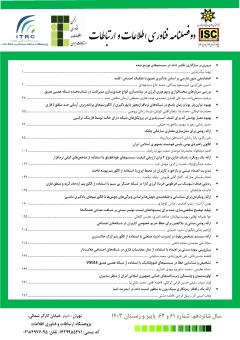ارائه سیستم تشخیص نفوذ در اینترنت اشیاء صنعتی با استفاده از الگوریتم گرگ خاکستری
محورهای موضوعی : فناوری اطلاعات و ارتباطات
سجاد علی محمدی
1
![]() ,
محمد فتحی
2
,
محمد فتحی
2
![]()
1 -
2 - دانشگاه کردستان
کلید واژه: سیستم تشخیص نفوذ, الگوریتم گرگ خاکستری, اینترنت اشیاء صنعتی,
چکیده مقاله :
امنیت یک هدف اصلی در طراحی شبکه اینترنت اشیاء صنعتی است. با توجه به پیشرفتهای روزافزون در اینترنت اشیاء لازم است از روشهای جدید در تشخیص حملات فعال شبکه استفاده شود. در این مقاله یک سیستم تشخیص نفوذ برای اینترنت اشیاء صنعتی پیشنهادشده است. این سیستم از ترکیب الگوریتمهای فرا ابتکاری گرگ خاکستری(GWO) و الگوریتمهای طبقهبندی درخت تصمیم(DT)، نزدیکترین همسایه (KNN) و شبکه عصبی مصنوعی(ANN) استفاده میکند. ابتدا دادهها پیشپردازش و سپس نرمالسازی شده، در مرحله بعد استخراج ویژگی دادهها با استفاده از الگوریتم گرگ خاکستری برای استخراج ویژگیهای مستقل و مؤثر آن انجام میشود. سپس با استفاده از الگوریتمهای طبقهبندی آموزش و درنهایت ارزیابی میشود. نتایج بهدستآمده نشان میدهد که استفاده از الگوریتم ترکیبی GWO-ANN با دقت 22/93 درصد در میزان تشخیص حملات عملکرد بهتری دارد. همچنین الگوریتم ANN نسبت به الگوریتمهای DT و KNN در تلفیق با الگوریتم GWO دارای دقت بالاتری است.
Security is a main goal in the design of industrial Internet of Things network. Due to the ever-increasing developments in the Internet of Things, it is necessary to use new methods to detect active network attacks. In this article, an intrusion detection system for industrial Internet of Things is proposed. This system uses the combination of gray wolf meta-heuristic algorithms (GWO) and decision tree (DT), nearest neighbor (KNN) and artificial neural network (ANN) classification algorithms. First, the data is pre-processed and then normalized, in the next step, data feature extraction is performed using the gray wolf algorithm to extract its independent and effective features. Then it is trained using classification algorithms and finally evaluated. The obtained results show that the use of the combined GWO-ANN algorithm with 93.22% accuracy has a better performance in detecting attacks. Also, the ANN algorithm is more accurate than the DT and KNN algorithms when combined with the GWO algorithm. ,
[1] X.Fei and G. Tian, "Fault Identification and Analysis of Communication NetworkBased on Deep Learning," 2022.
[2] J. Wan, J. Li, M. Imran and D. Li, "A blockchain-based solution for enhancing security and privacy in smart factory," IEEE Transactions on Industrial Informatics, vol. 15, no. 6, pp. 3652-3660, 2019.
[3] A. R. Sadeghi, C. Wachsmann and M. Waidner, "Security and privacy challenges in industrial internet of thing," In 2015 52nd ACM/EDAC/IEEE Design Automation Conference (DAC), pp. 1-6, June 2015.
[4] J. Sengupta, S. Ruj and S. D. Bit, "A comprehensive survey on attacks, security issues and blockchain solutions for IoT and IIoT," Journal of Network and Computer Applications, p. 149, 2020.
[5] M. Zolanvari, M. A. Teixeira, L. Gupta and K. Khan, "Machine learning-based network vulnerability analysis of industrial Internet of Things," IEEE Internet of Things Journal, vol. 6, no. 4, pp. 6822-6834, 2019.
[6] A. Deshpande, P. Pitale and S. Sanap, "Industrial automation using Internet of Things (IOT)," International Journal of Advanced Research in Computer Engineering & Technology (IJARCET), vol. 5, no. 2, pp. 266-269, 2016.
[7] ر. آرزم و ع. براتی، "ارائه روشی برای احراز هویت در اینترنت اشیاء مبتنی بر موقعیت گیرندههای Wi-Fi و فناوری زنجیره بلوکی"، پنجمین اجلاس ملی محاسبات توزیعی و پردازش دادههای بزرگ، ص ۱۸, ۱۳۹۸.
[8] ع. سید ترابی and ر. پهلوان, "رمزگذاری در احراز هویت دستگاههای اینترنت اشیا"، چهارمین اجلاس ملی ایدههای نوین در فنی و مهندسی، ص 24، 1398.
[9] ح. عیسی لو and ع. سلیمانی، "ارائه روشی کمبار برای احراز هویت اشیاء در اینترنت اشیا"، کنگره ملی تحقیقات بنیادین در مهندسی کامپیوتر و فناوری اطلاعات، ص 15، 1398.
[10] A. Derhab, M. Guerroumi, A. Gumaei, L. Maglaras, M. A. Ferrag, M. Mukherjee, et al., "Blockchain and random subspace learning-based ids for sdn-enabled industrial iot security", Sensors, vol. 19, no. 14, pp. 3119, 2019.
[11] D. K. K. Reddy, H. Behera, J. Nayak, B. Naik, U. Ghosh and P. K. Sharma, "Exact greedy algorithm based split finding approach for intrusion detection in fog-enabled iot environment", Journal of Information Security and Applications, vol. 60, pp. 102866, 2021.
[12] F. Zhang, H. A. D. E. Kodituwakku, J. W. Hines and J. Coble, "Multilayer data-driven cyber-attack detection system for industrial control systems based on network system and process data", IEEE Transactions on Industrial Informatics, vol. 15, no. 7, pp. 4362-4369, 2019.
[13] O. Eigner, P. Kreimel, P. Tavolato and P. Kreimel, "Detection of man-in-the-middle attacks on industrial control networks," in In 2016 International Conference on Software Security and Assurance (ICSSA), 2016.
[14] M. Zolanvari, . M. A. Teixeira, L. Gupta, . K. M. Khan and R. Jain, "Machine Learning-Based Network Vulnerability Analysis of Industrial Internet of Things," Internet of Things Journal, vol. 6, no. 4, pp. 6822-6833, 2019.
[15] S. Mirjalili, S. M. Mirjalili, and A. Lewis, “Grey Wolf Optimizer,” Advances in Engineering Software, vol. 69, pp. 46–61, Mar. 2014.
[16] C. M. Bishop, Pattern Recognition and Machine Learning. Springer, 2016.
[17] M. Tavallaee, E. Bagheri, W. Lu, and A. A. Ghorbani, “A detailed analysis of the KDD CUP 99 data set.” 2009 IEEE Symposium on Computational Intelligence for Security and Defense Applications, 2009.
[18] ل. عجمي بختياروند و ز. بهشتی، "روشی نوين برای خوشهبندی دادهها با استفاده از الگوريتم بهينهسازی چهارگرگ خاكستری," نشريه مهندسی برق و مهندسی كامپيوتر ايران، ب- مهندسي كامپيوتر، ص.ص 274-261،شماره 4، سال 19.


